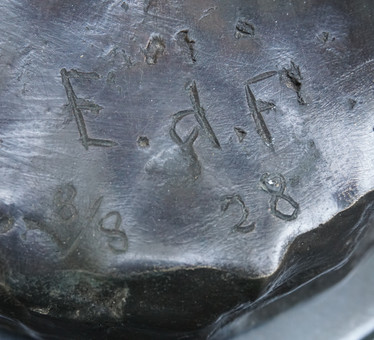Ernesto de Fiori

Roma, Italy, 1884 —
São Paulo, Brazil, 1945
Born in Rome, but descended from a family of Austrian origin, Ernesto De Fiori cultivated deeper ties with Germany than with his homeland, in fact becoming naturalized German at a young age. Renowned in Europe as a sculptor of quality and of a cosmopolitan spirit, the artist was forced, in the face of the terror of the Nazi rise, to emigrate to Brazil in 1936. Establishing himself in the city of São Paulo, where he already had family members, De Fiori called the attention of important critics and artists, including collaborating with the development of the São Paulo Artistic Family and the Santa Helena Group, environments in which it exerted a recognized influence.
Both in Europe and in São Paulo, Ernesto De Fiori’s sculptural production is characterized by a greater naturalism of the human figure in comparison to the modernist schematics in vogue, which marked Brazilian art through sculptors such as Victor Brecheret and Bruno Giorgi. In addition, the raised skin of the figures draws special attention, resulting from the agile and energetic form with which the artist modeled and which produces an interesting effect of light and shadows on the surface of the works, as can be seen in the famous bust of actress Marlene Dietrich (1931 ) and in the work Hands in the hair (1940). Another aspect of Ernesto De Fiori’s sculpture is the inner tension and seriousness emanating even from sculptures such as The Athlete at Rest (1938) and the bust of his young nephew, Christian Heins de Fiori (1939); such attributes give his works a general expressionist effect.
Some differences can be noticed between the works that the artist did in Europe and those developed in Brazil, such as the advent of a more generous material volume and a subtle rounding of sculptural forms, distinctions that can be exemplified by the comparison between Adam sculptures ( 1929) and Standing Woman (1937). Even so, such changes are not enough to accommodate De Fiori in the Brazilian modernist aesthetic of the time. Around 1938, all the works that De Fiori sent to the gardens of the then new headquarters of the Ministry of Education and Health, the Capanema Palace, designed by the hard core of architectural modernism and one of its maximum emblems in the country, are rejected.
It is also in Brazil that De Fiori resolutely returns to painting and drawing, especially from 1940 onwards. One can even believe that especially in painting, the artist finds a line of communication between himself and the Brazilian reality. Here, it is the rural and urban landscapes, the sailing boats, the still lifes and the everyday scenes that stretch on a melancholic bridge between the lament and the uncertainty, as if the bronze O Fugitivo (1936) left Germany already nonexistent and decayed in which he had been abandoned and found, on the other side of the Atlantic, the incomplete and precarious city painted in Vista de São Paulo (nd).
GGS